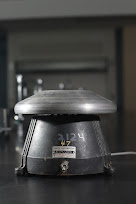Uses different sizes of solid objects in a heterogeneous mixture to separate them using some sort of device that lets the smaller objects fall through.For instance, if you had (for some bizarre reason) mixed peanuts into your flour, you could use a sifter to separate them.
Uses different sizes of molecules when a solid is mixed into a liquid in a heterogeneous mixture (a suspension) to separate them. The mixture is passed through a filter of some sort (a porous material) and the larger solid molecules are trapped as the liquid goes through.For instance, if you poured muddy water through a filter paper, the large solids would be trapped and the liquid would go through.
The liquid that goes through the filter and comes out is called the filtrate.
Layering: A heterogeneous mixture (a suspension) will separate if let sitting such that the most dense particles particles settling to the bottom and the less dense rising to the top. (Think chocolate milk or orange juice).
Centrifugal Separation: Using a device called a centrifuge, heterogeneous samples can be separated. The spinning of the samples in the centrifuge has the effect to "sling" the more dense particles to the outside (Imagine riding a one of those spinning rides at the fair!). A centrifuge will separate mixtures into layers with the most dense particles at the bottom of the test tube.
Uses different boiling points when a (usually) solid is mixed into a liquid in a homogeneous mixture (a colloid or a solution) to separate them. The mixture is heated and the substance with the lowest boiling point boils away first (lost to the atmosphere) leaving behind the substance with the higher boiling point.For instance, if you boil saltwater until all the water is gone, you have the salt left in the [pot / evaporation dish / beaker / bowl / whatever].
Uses different boiling points of two substances in a homogeneous mixture (a colloid or a solution) to separate them. The mixture is heated and the substance with the lowest boiling point boils away first then passes through a cooling mechanism where it is condensed and collected. The (usually) liquid that has the higher boiling point is left behind.
The substance collected (with the lower boiling point) is called the distillate.
A lab technique in which mixtures can be separated by dissolving them in a fluid then passing the fluid through a medium in which the different constituent parts move at different rates. MORE
Giant Macro example: A mixture of cars and trucks going up a hill—the fact that they go at different rates will result in the faster ones separating from the slower ones.
A very simple example of Chromatography can be done using black water-based ink on a porous paper. There are some variables such as whether or not to wet the paper first, but the mixture of pigments will separate based on which ones will move most quickly through the paper.
A mixture or red, blue, green, and yellow food coloring (looks black in the mixture) dropped onto filter paper will separate into the various pigments. In the image (Fig 1), most notably, are the bands at the edge showing the blue, green, and brownish rings.
In more formal applications, the mixture is dissolved in a fluid that will carry the parts. The fluid is called the mobile phase. The fluid is carried through another material called the stationary phase. Depending on the substances composition, they will pass through at different speeds causing them to separate.



No comments:
Post a Comment